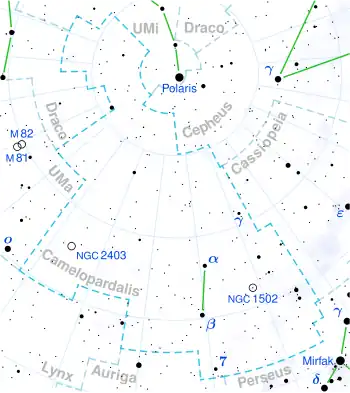
Struve 1694 (Σ 1694, Struve 1694) is a double star in the constellation Camelopardalis.[1]
Σ 1694 is a double star, with components of magnitudes 5.3m and 5.9m:
- Σ 1694A (HD 112028) is a white A-type giant star with an apparent magnitude of 5.28m. It is approximately 300 light years from Earth.
- Σ 1694B (HD 112014) is a spectroscopic binary consisting of two A-type main sequence stars.
Norton's Star Atlas describes the pair as yellowish and bluish.[1]
Σ 1694 was also known as 32H. Camelopardalis, Hevelius' 32nd of Camelopardalis. It is not Flamsteed's "32 Camelopardalis", which is ξ Aurigae. In the British Association Catalogue, the star pair are listed as being in Ursa Minor.[2]
Chinese name
In Chinese, 北極 (Běi Jí), meaning North Pole, refers to an asterism consisting of Σ 1694, γ Ursae Minoris, β Ursae Minoris, 5 Ursae Minoris and 4 Ursae Minoris.[3] Consequently, Σ 1694 itself is known as 北極五 (Běi Jí wǔ, English: the Fifth Star of North Pole.),[4] representing 天樞 (Tiānshū), meaning Celestial Pivot.[5]
This star was regarded as the north star by the Chinese people from Han Dynasty to Song Dynasty.
References
- 1 2 Norton, Arthur P. (1973). Norton's Star Atlas. p. 118. ISBN 0-85248-900-5.
- ↑ British Association for the Advancement of Science; Francis Baily (1845). The Catalogue of Stars of the British Association for the Advancement of Science: Containing the Mean Right Ascensions and North Polar Distances of Eight Thousand Three Hundred and Seventy-seven Fixed Stars, Reduced to January 1, 1850: Together with Their Annual Precessions, Secular Variations and Proper Motions, as Well as the Logarithmic Constants for Computing Precession, Aberration and Nutation. With a Preface Explanatory of Their Construction and Application. R. and J. E. Taylor.
- ↑ (in Chinese) 中國星座神話, written by 陳久金. Published by 台灣書房出版有限公司, 2005, ISBN 978-986-7332-25-7.
- ↑ (in Chinese) 天樞 (北極)
- ↑ (in Chinese) 香港太空館 - 研究資源 - 亮星中英對照表 Archived 2010-08-10 at the Wayback Machine, Hong Kong Space Museum. Accessed on line November 23, 2010.